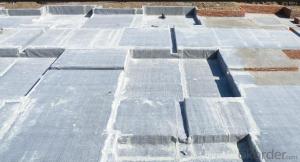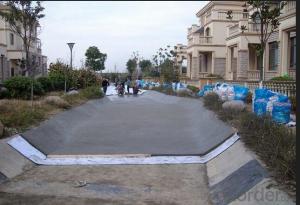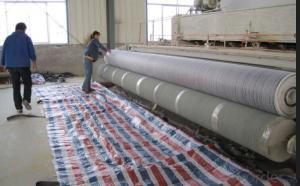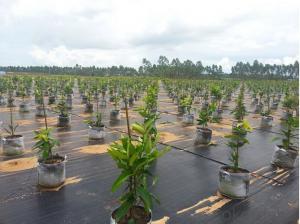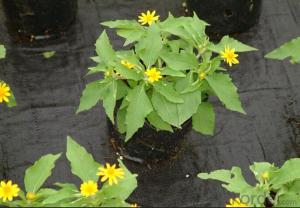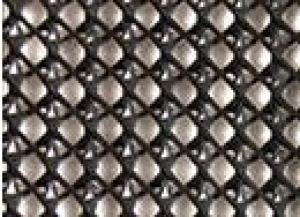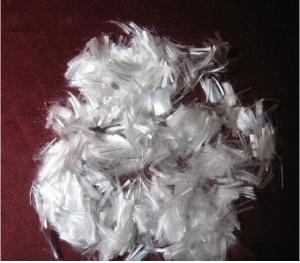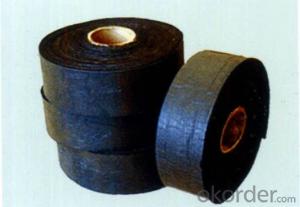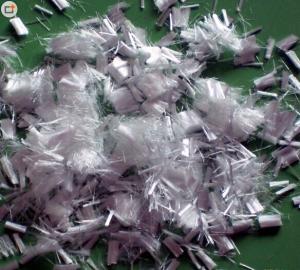Geosynthetic Clay Liner(GCL) for Anti-seepage
- Loading Port:
- Qingdao
- Payment Terms:
- TT OR LC
- Min Order Qty:
- 5000 m²
- Supply Capability:
- 100000 m²/month
OKorder Service Pledge
OKorder Financial Service
You Might Also Like
sodium Bentonite Geosynthetic Clay Liner(GCL) for anti-seepage
1,Introduction
GCL is a new geosynthetics. It is graded by a natural sodium bentonite particles and corresponding additive mixed together, By special technology and equipment, the bentonite particles between two layers of geotextile fixed, made of waterproof blanket, with all the characteristics of both the geotextile material, but also has excellent water (infiltration) performance.
2,Feature
(1) A permanent waterproof performance, and excellent water seepage performance, impermeability hydrostatic pressure up to 1.0MPa above, permeability coefficient 5 *10-9cm / s. Because the Department of Natural sodium bentonite inorganic materials, even after a long time or the surrounding environment changes, aging or corrosion does not occur.
(2) Has all the characteristics of geotextile material, such as separation, reinforcement, protection, filtration, simple construction and unrestricted construction environment temperature below 0 0 C also be construction. Just when construction GCL waterproof blanket tile on the floor, when the elevation or slope construction, with nails and washers to secure it, as required, can overlap.
(3) Easy to repair; Even after water (seepage) end of construction, such as waterproof layer accident damage, as long as the site of the damage to be a simple fix, can ever regain perfect waterproof performance.
(4)green: Bentonite is a natural inorganic material, harmless, non-toxic, no particular impact on the environment, with good environmental performance.
(5) simple construction period is short: and other waterproof materials, the construction is relatively simple, does not require heating and paste. Product width up to 6 meters, with international geotextile (film) to match the size, greatly improving the efficiency of construction.
(6) Integrated waterproof materials and objects: When sodium bentonite water, with 20-28 times the capacity expansion, even if the concrete structure vibration and settlement, bentonite GCL can repair cracks in the concrete surface less than 2mm.
3,Application
(1)Municipal engineering, underground engineering subways, buildings and roofs reservoir seepage.
(2)Environmental sanitation, solid waste landfills, sewage treatment plants, industrial waste.
(3)water, rivers, lakes and reservoirs dam seepage, plugging, reinforcement.
(4)Garden artificial lake golf course pond seepage and so on.
(5)Petrochemical, mining and other areas of engineering seepage, leakage, etc.
4,Specification of Geosynthetic Clay Liner(GCL) for anti-seepage
PROPERTIES | Test Method | Typical Value |
BENTONITE PROPERTIES | ||
Bentionite Swell Index | ASTM D 5890 | ≥24ml/2g |
Bentionite Fluid Loss | ASTM D 5891 | ≤18ml |
Finished GCL PROPERTIES | ||
Bentionite Mass/Unit Area | ASTM D 5993 | ≥3.6kg/sq.m |
Peel Strength | ASTM D 6496 | ≥400N/m |
Grab Strength | ASTM D 6768 | ≥6kN/m |
Thickness | ASTM D 5199 | ≥6mm |
Permeability | ASTM D 5084 | ≤5.0×10-11m/sec |
Index Flux | ASTM D 5887 | ≤1.0×10-8m3/m2/sec |
Geotextile PROPERTIES | ||
Non-Woven Geotextile Mass | ASTM D 5261 | ≥200g/sq.m |
Woven Geotextile Mass | ASTM D 5261 | ≥110g/sq.m |
ROLL DIMENSIONS | ||
Width | Normal | 5.8m |
Length | Normal | 30m |
Package | Normal | PE Film |
PROPERTIES | Test Method | Typical Value |
BENTONITE PROPERTIES | ||
Bentionite Swell Index | ASTM D 5890 | ≥24ml/2g |
Bentionite Fluid Loss | ASTM D 5891 | ≤18ml |
Finished GCL PROPERTIES | ||
Bentionite Mass/Unit Area | ASTM D 5993 | ≥3.6kg/sq.m |
Peel Strength | ASTM D 6496 | ≥400N/m |
Grab Strength | ASTM D 6768 | ≥6kN/m |
Thickness | ASTM D 5199 | ≥6mm |
Permeability | ASTM D 5084 | ≤5.0×10-11m/sec |
Index Flux | ASTM D 5887 | ≤1.0×10-8m3/m2/sec |
Geotextile PROPERTIES | ||
Non-Woven Geotextile Mass | ASTM D 5261 | ≥200g/sq.m |
Woven Geotextile Mass | ASTM D 5261 | ≥110g/sq.m |
ROLL DIMENSIONS | ||
Width | Normal | 5.8m |
Length | Normal | 30m |
Package | Normal | PE Film |
FAQ:
How many quantity for one 20'' container?
About 5,000m2, 16rolls
What's your delivery time?
About 15-20days against deposit received
. What's your package?
Per roll with two pieces woven bag
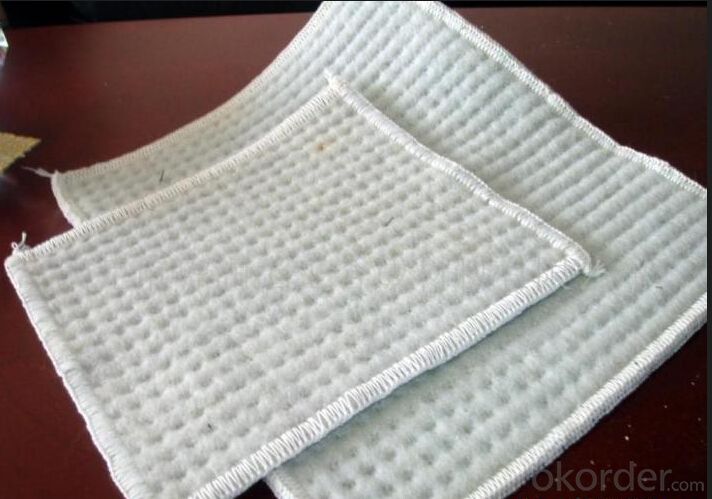
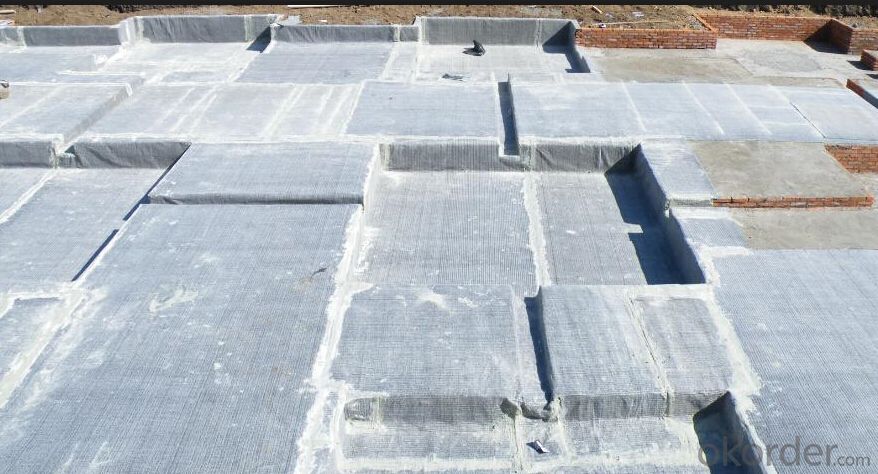
- Q:What is the function of geosynthetic drainage materials in road shoulder construction?
- The function of geosynthetic drainage materials in road shoulder construction is to provide efficient drainage and prevent water accumulation, which helps in maintaining the stability and durability of the road shoulder.
- Q:What are the specific applications of geosynthetic clay liners in earthwork projects?
- Geosynthetic clay liners (GCLs) have several specific applications in earthwork projects. They are commonly used as a barrier or liner in landfills to prevent the migration of contaminants into the surrounding soil and groundwater. GCLs are also utilized in pond liners, canal linings, and reservoirs to provide impermeability and prevent seepage. Additionally, they are used in erosion control measures, such as slope stabilization and embankment protection, to enhance the soil's resistance to erosion. Overall, GCLs play a crucial role in ensuring environmental protection, water conservation, and long-term stability in various earthwork projects.
- Q:How do earthwork products help with wetland creation?
- Earthwork products, such as fill materials and geotextiles, play a crucial role in wetland creation by providing necessary structural support and promoting appropriate hydrological conditions. Fill materials are used to elevate the ground and create suitable topography for wetlands, ensuring proper water retention and drainage. Geotextiles, on the other hand, aid in erosion control and stabilization of soil, preventing sedimentation and promoting vegetation growth. By using earthwork products, wetland creation projects can effectively mimic natural wetland conditions and establish a thriving ecosystem.
- Q:Are earthwork products environmentally friendly?
- Earthwork products can be considered environmentally friendly because they are typically made from natural materials and do not release harmful chemicals or pollutants into the environment. Additionally, earthwork products often have a low carbon footprint compared to other construction materials, as they require minimal processing and transportation. However, the specific environmental impact can vary depending on the sourcing, manufacturing process, and disposal methods of these products.
- Q:What are the benefits of using geotextile tubes for land reclamation projects?
- Geotextile tubes offer several benefits for land reclamation projects. Firstly, they provide a cost-effective solution by utilizing locally available fill material instead of importing expensive fill materials. Secondly, they are highly efficient in dewatering and solidifying the sediments, reducing the volume and weight of material to be disposed of. Additionally, geotextile tubes have a small environmental footprint as they minimize disturbance to surrounding habitats and ecosystems. Lastly, they provide stability and erosion control, preventing soil erosion and protecting the newly reclaimed land against wave action and currents.
- Q:What are the basic properties of civil engineering materials?
- In engineering practice, the selection, use, analysis and evaluation of materials is usually based on its nature. The nature of civil engineering materials can be divided into two parts: the basic nature and the special nature.
- Q:What are the advantages of using geosynthetic materials in airport runway construction?
- There are several advantages of using geosynthetic materials in airport runway construction. Firstly, geosynthetic materials offer improved stability and strength to the runway structure. These materials have high tensile strength and can withstand heavy loads, ensuring the runway can support the weight of aircrafts without excessive deformation or settlement. Secondly, geosynthetics provide effective drainage and water management. They have excellent filtration properties, allowing water to pass through while preventing soil particles from clogging the system. This helps in maintaining the integrity of the runway by preventing water accumulation and reducing the risk of erosion or weakening of the foundation. Additionally, geosynthetics offer enhanced soil reinforcement. By incorporating geotextiles or geogrids into the runway construction, the load-bearing capacity of the soil can be significantly increased. This allows for the use of weaker or less expensive soil materials, reducing the overall construction costs. Moreover, geosynthetic materials are easy to install and require less labor compared to traditional construction methods. They can be prefabricated off-site, reducing the construction time and minimizing disruptions to airport operations. This makes geosynthetic materials a cost-effective and efficient choice for runway construction. Overall, the use of geosynthetic materials in airport runway construction provides improved stability, effective drainage, enhanced soil reinforcement, and cost savings. These advantages make geosynthetics an ideal choice for ensuring the durability and longevity of airport runways.
- Q:Are there any earthwork products specifically designed for playground construction?
- Yes, there are earthwork products specifically designed for playground construction. These products include materials such as engineered wood fiber, rubber mulch, and synthetic turf that are commonly used as safety surfaces to cushion falls and reduce injuries in playgrounds. Additionally, there are other earthwork products like retaining walls, drainage systems, and erosion control measures that are often incorporated into playground construction to ensure long-term stability and safety.
- Q:What are the different applications of geotextile filter fabrics?
- Geotextile filter fabrics have various applications such as erosion control, drainage systems, road construction, retaining walls, landfill liners, and shoreline protection. They are used to separate two different materials, allowing water to pass through while retaining the soil or aggregate, thereby preventing erosion and promoting stability in various civil engineering projects.
- Q:Can earthwork products be used for fish passage construction?
- Yes, earthwork products can be used for fish passage construction. Earthwork products such as soil, gravel, and rocks can be utilized to create channels, ramps, and other structures that help facilitate the movement of fish through waterways. These materials can be strategically placed to create the desired flow conditions and provide the necessary habitat for fish to navigate barriers and reach their spawning grounds.
1. Manufacturer Overview |
|
|---|---|
| Location | |
| Year Established | |
| Annual Output Value | |
| Main Markets | |
| Company Certifications | |
2. Manufacturer Certificates |
|
|---|---|
| a) Certification Name | |
| Range | |
| Reference | |
| Validity Period | |
3. Manufacturer Capability |
|
|---|---|
| a)Trade Capacity | |
| Nearest Port | |
| Export Percentage | |
| No.of Employees in Trade Department | |
| Language Spoken: | |
| b)Factory Information | |
| Factory Size: | |
| No. of Production Lines | |
| Contract Manufacturing | |
| Product Price Range | |
Send your message to us
Geosynthetic Clay Liner(GCL) for Anti-seepage
- Loading Port:
- Qingdao
- Payment Terms:
- TT OR LC
- Min Order Qty:
- 5000 m²
- Supply Capability:
- 100000 m²/month
OKorder Service Pledge
OKorder Financial Service
Similar products
New products
Hot products
Hot Searches
Related keywords
